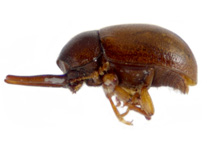Abstract
Four new species of terrestrial earthworms belonging to the genus Amynthas were collected on the islands of Kinmen and Lieyu, Taiwan from March to November, 2008. They are Amynthas kinmenensis sp. nov., Amynthas wuhumontis sp. nov., Amynthas wujhouensis sp. nov., and Amynthas taiwumontis sp. nov. Amynthas kinmenensis sp. nov. is quadrithecal and is the most abundant earthworm widely distributed on the main island of Kinmen. It has numerous small genital papillae and is closely related to Amynthas polyglandularis (Tsai, 1964) from northern Taiwan. Amynthas wuhumontis sp. nov. is sexthecal and is distributed only in areas around Mt. Wuhu and Mt. Taiwu in east Kinmen. It has male pores each surrounded by three genital papillae: one anterior, one posterior and one medial. Amynthas wujhouensis sp. nov. and Amynthas taiwumontis sp. nov. are octothecal. The former has a sporadic distribution in Kinmen while the latter was only found in areas around Mt. Taiwu. Amynthas wujhouensis sp. nov. has a pair of large genital papillae closely adjacent to the crescent or semicircular shaped male porophores in XVIII. Amynthas taiwumontis sp. nov. has simple male pore structure and no genital papillae or genital markings. DNA barcodes (the 5’ end sequences of the mitochondrial cytochrome c oxidase subunit 1 gene) from type specimens and other materials of the first three species are also reported.
References
Abdullah, M. (1973) The systematic position of Cisidae (Heteromera) including a catalogue of the world and comments on central European families of Cucojoidea (Coleoptera). Zoologische Beiträge, 19, 189–246.
Evenhuis, N.L. (2008) A Compendium of Zoological Type Nomenclature: a Reference Source. Bishop Museum Technical Report, 41, 1–23.
Gorham, H.S. (1883) Macrocis. In: Gorham, H.S., Biologia Centrali-Americana: Insecta: Coleoptera. Malacordermata. Vol. 3 Part 2. Published for the editors by R.H. Porter, London, pp. 219–220.
Graf-Peters, L.V., Lopes-Andrade, C., da Silveira, R.M.B., Moura, L.A., Reck, M.A. & Sá, F.N. (2011) Host fungi and feeding habits of Ciidae (Coleoptera) in a subtropical rainforest in southern Brazil, with an overview of host fungi of Neotropical ciids. Florida Entomologist, 94(3), 553–566. http://dx.doi.org/10.1653/024.094.0320
Halffter, G. (1964) La entomofauna americana, ideas acerca de su origen y distribución. Folia Entomologica, 6, 1–108.
Kawanabe, M. (1997) The Japanese Species related to the Group of Cis nitidus (Coleoptera, Ciidae). Elytra, 25(2), 311–331.
Lawrence, J.F. (1971) Revision of the North American Ciidae (Coleoptera). Bulletin of Museum of Comparative Zoology, 142(5), 419–522.
Lawrence, J.F. (1973) Host preference in ciid beetles (Coleoptera: Ciidae) inhabiting the fruiting bodies of Basidiomycetes in North America. Bulletin of the Museum of Comparative Zoology, 145, 163–212.
Liebherr, J.K. (1986) Barylaus, new genus (Coleoptera: Carabidae) endemic to the West Indies, with Old World affinities. Journal of New York Entomological, 94, 83–97.
Lopes-Andrade, C. (2002) Two cases of hononymy in the genus Cis Latreille (Coleoptera: Tenebrionoidea: Ciidae). Dugesiana, 9(2), 54. http://dx.doi.org/10.3897/zookeys.81.940
Lopes-Andrade, C. (2011) The first Strigocis Dury (Coleoptera, Ciidae) from the southern Neotropical region and a provisional key to world species. ZooKeys, 81, 27–37.
Lopes-Andrade, C. & Lawrence, J.F. (2005) Phellinocis, a new genus of Neotropical Ciidae (Coleoptera : Tenebrionoidea). Zootaxa, 1034, 43–60.
Morrone, J.J., Espinosa, D., Aguilar, C. & Llorente, J. (1999) Preliminary classification of the Mexican biogeographic provinces: a parsimony analysis of endemicity based on plant, insect, and bird taxa. The Southwestern Naturalist, 44(4), 507–544. http://dx.doi.org/10.2307/3672351
Morrone, J.J. & Márquez, J. (2001) Halffter’s Mexican transition zone, beetle generalized tracks, and geographical homology. Journal of Biogeography, 28, 635–50. http://dx.doi.org/10.1046/j.1365-2699.2001.00571.x
Morrone, J.J. (2006) Biogeographic areas and transitonal zones of Latin America and the Caribbean islands based on panbiogeographic and cladistic analyses of the entomofauna. Annual Review Entomological, 51, 467–494. http://dx.doi.org/10.1146/annurev.ento.50.071803.130447
Navarrete-Heredia, J.L. & Burgos-Solorio, A. (2000) Ciidae (Coleoptera). In Bousquets, J.EL., Soriano, E.G. & Papavero, N. (Eds.), Biodiversidad, Taxonomía y Biogeografía de Artrópodos de México: Hacia uma síntese de su conocimiento, Vol 2. D.F.: UNAM/CONABIO/Bayer de México, México, pp. 413–419.
Pic, M. (1916) Diagnoses génériques et spécifiques. Mélanges Exotico-Entomologiques, 18, 1–20.
Pic, M. (1917) Descriptions abregées diverses. Mélanges Exotico-Entomologiques, 26, 4.
Pic, M. (1922) Nouveautés Diverses. Mélanges Exotico-Entomologiques, 35, 3.
Reitter, E. (1878) Neue Cioidae. Mittheilungen der Münchener Entomologischen Vereins, 2, 32–37.

